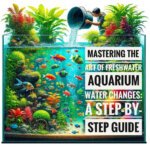Chemical Filtration Media Explained: Enhancing Water Quality in Your Reef Tank
Introduction: In the intricate ecosystem of a reef tank, maintaining pristine water quality is paramount for the health and vibrancy of its inhabitants. While mechanical and biological filtration play crucial roles in removing physical debris and waste, chemical filtration provides an additional layer of purification by targeting dissolved impurities and toxins. In this comprehensive guide, we’ll delve into the world of chemical filtration media, exploring different types such as activated carbon and phosphate removers, and discussing when and how to use them effectively in your reef tank.
Understanding Chemical Filtration
Chemical filtration involves the use of specialised media to adsorb or remove dissolved impurities from aquarium water. Unlike mechanical filtration, which physically traps particles, and biological filtration, which breaks down organic waste, chemical filtration targets molecules at the molecular level. This process helps to improve water clarity, remove odours, and reduce harmful substances that can compromise the health of coral, fish, and invertebrates.
Types of Chemical Filtration Media
Activated Carbon: Activated carbon is perhaps the most widely used chemical filtration media in reef aquariums. It consists of porous carbon granules with a large surface area, allowing it to adsorb a wide range of organic molecules, toxins, and pigments from the water. Activated carbon is effective at removing dissolved organic compounds, medications, and foul odours, making it an essential component of many filtration systems. It should be replaced regularly to maintain its effectiveness.
Phosphate Removers: Excessive phosphate levels in a reef tank can lead to algae overgrowth, coral bleaching, and poor water quality. Phosphate removers are chemical filtration media designed to bind and remove phosphates from the water, helping to control algae growth and promote the health of corals. These products typically contain compounds such as ferric oxide or aluminium oxide, which chemically react with phosphates to form insoluble compounds that can be easily removed by filtration.
Ion Exchange Resins: Ion exchange resins are another type of chemical filtration media commonly used in reef aquariums. These resins contain charged particles that attract and bind ions of specific substances, such as ammonia, nitrate, or heavy metals. By exchanging ions with undesirable substances in the water, ion exchange resins help to remove pollutants and maintain water quality. They can be particularly useful in controlling nutrient levels and preventing toxic spikes in a reef tank.
When to Use Chemical Filtration Media
The use of chemical filtration media in a reef tank should be carefully considered based on the specific needs of the aquarium and the water parameters. Here are some scenarios where chemical filtration may be beneficial:
- New Tank Setup: During the initial cycling phase of a new reef tank, chemical filtration media can help to remove excess nutrients and contaminants, creating a clean and stable environment for the introduction of livestock.
- Water Clarity Issues: If the water in your reef tank appears cloudy or discoloured, activated carbon can be used to improve water clarity by removing organic compounds and pigments.
- Algae Control: Phosphate removers can be employed to reduce phosphate levels and control algae growth, helping to maintain a balanced and algae-free reef tank environment.
- Medication Removal: After treating fish or corals with medications, activated carbon can be used to remove residual medications from the water, preventing potential harm to other tank inhabitants.
Conclusion
Chemical filtration media play a vital role in maintaining water quality and promoting the health of marine life in a reef tank. By understanding the different types of chemical filtration media available, such as activated carbon and phosphate removers, and knowing when to use them, reef hobbyists can create a clean, stable, and thriving aquatic environment for their beloved corals, fish, and invertebrates. Remember to monitor water parameters regularly and replace chemical filtration media as needed to ensure optimal performance and long-term success in your reef tank journey.








